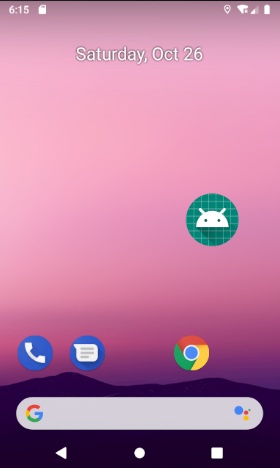Window表示一个悬浮窗口,在开发直接接触的并不多,但是当我们需要使用在桌面上显示一个悬浮窗的东西的时候Window就派上用场了。Window是一个抽象类,它的具体实现时PopupWindow类,创建Window很简单,只需要通过WindowManager即可完成。WindowManager是外界访问Window的入口。
Window和WindowManager之间的联系
为了分析Window的工作机制,使用WindowManager来添加一个Window
floatingButton=new Button(this);
floatingButton.setText("123");
mLayoutParams=new WindowManager.LayoutParams(LayoutParams.WRAP_CONTENT,LayoutParams.WRAP_CONTENT,0,0,PixelFormat.TRANSPARENT);
mLayoutParams.flags=LayoutParams.FLAG_NOT_TOUCH_MODAL|LayoutParams.FLAG_NOT_FOCUSABLE|LayoutParams.FLAG_SHOW_WHEN_LOCKED;
mLayoutParams.gravity=Gravity.LEFT|Gravity.TOP;
mLayoutParams.x=100;
mLayoutParams.y=300;
mWindowManager.addView(floatingButton,mLayoutParams);
在构建WindowManager.LayoutParams时,其中的type和flags是非常重要的.
flags参数有很多选项,用来控制Window的显示特性
- FLAG_NOT_FOCUSABLE——表示此Window不需要获取焦点,不接受各种输入事件,此标记会同时启用FLAG_NOT_TOUCH_MODAL,最终事件会直接传递给下层具有焦点的Window
- FLAG_NOT_TOUCH_MODAL——自己Window区域内的事件自己处理,自己Window区域外的事件传递给底层Window处理。一般这个选项会默认开启,否则其他Window无法收到事件
- FLAG_SHOW_WHEN_LOCKED——可以让Window显示在锁屏上
type参数时int类型,表示Window的类型。Window有三种类型
- 应用Window——对应着一个Activity,层级范围1~99;
- 子Window——不能独立存在,需要附属在特定的父Window种,比如Dialog就是一个子Window。层级范围1000~1999;
- 系统WIndow——需要声明权限才能创建,如Toast和系统状态栏都是系统Window,层级范围2000~2999;
Window是分层的,层级大的Window会覆盖在层级小的Window上面。
WindowManager提供的功能很简单,常用的只有三个方法,即添加View,更新View和删除View。这三个方法定义在ViewManager种,而WindowManager继承自ViewManager。
public interface ViewManager{
public void addView(View view,ViewGroup.LayoutParams params);
public void updateViewLayout(View view,ViewGroup.LayoutParams params);
public void removeView(View view);
}
应用悬浮窗实例:
public class MainActivity extends AppCompatActivity implements View.OnClickListener, View.OnTouchListener {
private static final String TAG="TestActivity";
private Button addBtn,rmvBtn;
private ImageView imageView;
private WindowManager windowManager;
private WindowManager.LayoutParams layoutParams;
@Override
protected void onCreate(Bundle savedInstanceState) {
super.onCreate(savedInstanceState);
setContentView(R.layout.activity_main);
//当API大于23时需要在代码中动态申请权限
if(Build.VERSION.SDK_INT>=Build.VERSION_CODES.M){
Intent intent=new Intent(Settings.ACTION_MANAGE_OVERLAY_PERMISSION);
startActivityForResult(intent,100);
}else {
initView();
}
}
private void initView() {
addBtn=findViewById(R.id.add_btn);
rmvBtn=findViewById(R.id.remocve_btn);
addBtn.setOnClickListener(this);
rmvBtn.setOnClickListener(this);
windowManager=(WindowManager) getApplicationContext().getSystemService(Context.WINDOW_SERVICE);
}
@Override
protected void onActivityResult(int requestCode, int resultCode, @Nullable Intent data) {
super.onActivityResult(requestCode, resultCode, data);
if(requestCode==100){
initView();
}
}
@Override
public void onClick(View v) {
switch (v.getId()){
case R.id.add_btn:
addView();
break;
case R.id.remocve_btn:
removeView();
break;
}
}
private void removeView() {
windowManager.removeViewImmediate(imageView);
}
private void addView() {
imageView = new ImageView(this);
imageView.setBackgroundResource(R.mipmap.ic_launcher);
layoutParams = new WindowManager.LayoutParams(WindowManager.LayoutParams.WRAP_CONTENT
, WindowManager.LayoutParams.WRAP_CONTENT, 2099,
WindowManager.LayoutParams.FLAG_NOT_TOUCH_MODAL
| WindowManager.LayoutParams.FLAG_NOT_FOCUSABLE
| WindowManager.LayoutParams.FLAG_SHOW_WHEN_LOCKED
, PixelFormat.TRANSPARENT);
layoutParams.type = WindowManager.LayoutParams.TYPE_APPLICATION_OVERLAY;
layoutParams.gravity = Gravity.TOP | Gravity.LEFT;
layoutParams.x = 0;
layoutParams.y = 300;
imageView.setOnTouchListener(this);
windowManager.addView(imageView, layoutParams);
}
@Override
public boolean onTouch(View v, MotionEvent event) {
int rawX=(int) event.getRawX();
int rawY=(int) event.getRawY();
switch (event.getAction()){
case MotionEvent.ACTION_MOVE: {
layoutParams.x = rawX;
layoutParams.y = rawY;
windowManager.updateViewLayout(imageView, layoutParams);
break;
}
default:
break;
}
return true;
}
}
在XML中直接添加了两个Button
实现效果:


Window的内部机制
window是一个抽象概念,每一个Window都对应着一个View和ViewRootImpl,Window和View通过ViewRootImpl来建立联系。因此Window并不是实际存在的,而是以View的形式存在。 在实际使用中无法直接访问Window,对Window的访问必须同通过WindowManager。在WindowManager住要提供了三个接口方法,addView,updateViewLayout,removeView,所以我们就从Window的添加,更新,删除来看它的内部机制。
Window添加的过程
在WindowManager中真正实现三大操作的是WindowManagerImpl类,在WindowManagerImpl中Window的三大操作如下:
@Override
public void addView(@NonNull View view, @NonNull ViewGroup.LayoutParams params) {
applyDefaultToken(params);
mGlobal.addView(view, params, mContext.getDisplay(), mParentWindow);
}
@Override
public void updateViewLayout(@NonNull View view, @NonNull ViewGroup.LayoutParams params) {
applyDefaultToken(params);
mGlobal.updateViewLayout(view, params);
}
@Override
public void removeView(View view) {
mGlobal.removeView(view, false);
}
在代码中看到了一个mGlobal,发现这一些列操作都是由他来实现的,来看看mGlobal是何方神圣。
private final WindowManagerGlobal mGlobal = WindowManagerGlobal.getInstance();
这个mGlobal是一个WindowManagerGlobal类的实例,那么继续查看在这个类中是如何实现我们的三大操作的呢?
WindowManagerGlobal中的addView如下:
public void addView(View view, ViewGroup.LayoutParams params,
Display display, Window parentWindow) {
//检查参数是否合法,如果是子Window那么还需要调整一些布局参数
if (view == null) {
throw new IllegalArgumentException("view must not be null");
}
if (display == null) {
throw new IllegalArgumentException("display must not be null");
}
if (!(params instanceof WindowManager.LayoutParams)) {
throw new IllegalArgumentException("Params must be WindowManager.LayoutParams");
}
final WindowManager.LayoutParams wparams = (WindowManager.LayoutParams) params;
if (parentWindow != null) {
//当是子Window的时候需要调整参数通过adjustLayoutParamsForSubWindow这个方法
parentWindow.adjustLayoutParamsForSubWindow(wparams);
} else {
//如果没有父视图,则此视图的硬件加速将从应用程序的硬件加速设置中设置。
final Context context = view.getContext();
if (context != null
&& (context.getApplicationInfo().flags
& ApplicationInfo.FLAG_HARDWARE_ACCELERATED) != 0) {
wparams.flags |= WindowManager.LayoutParams.FLAG_HARDWARE_ACCELERATED;
}
}
ViewRootImpl root;
View panelParentView = null;
synchronized (mLock) {
// Start watching for system property changes.
if (mSystemPropertyUpdater == null) {
mSystemPropertyUpdater = new Runnable() {
@Override public void run() {
synchronized (mLock) {
for (int i = mRoots.size() - 1; i >= 0; --i) {
mRoots.get(i).loadSystemProperties();
}
}
}
};
SystemProperties.addChangeCallback(mSystemPropertyUpdater);
}
int index = findViewLocked(view, false);
if (index >= 0) {
if (mDyingViews.contains(view)) {
// Don't wait for MSG_DIE to make it's way through root's queue.
mRoots.get(index).doDie();
} else {
throw new IllegalStateException("View " + view
+ " has already been added to the window manager.");
}
// The previous removeView() had not completed executing. Now it has.
}
// If this is a panel window, then find the window it is being
// attached to for future reference.
if (wparams.type >= WindowManager.LayoutParams.FIRST_SUB_WINDOW &&
wparams.type <= WindowManager.LayoutParams.LAST_SUB_WINDOW) {
final int count = mViews.size();
for (int i = 0; i < count; i++) {
if (mRoots.get(i).mWindow.asBinder() == wparams.token) {
panelParentView = mViews.get(i);
}
}
}
//下列操作将Window的一系列对象添加到列表中
root = new ViewRootImpl(view.getContext(), display);
view.setLayoutParams(wparams);
//mView存储的是所有Window对应的View
mViews.add(view);
//mRoots存储的是所有Window所对应的ViewRootImpl
mRoots.add(root);
//mParams存储的是所有Window所对应的布局参数
mParams.add(wparams);
// do this last because it fires off messages to start doing things
try {
//通过ViewRootImpl的实例root.setView来更新界面并完成Window的添加过程
root.setView(view, wparams, panelParentView);
} catch (RuntimeException e) {
// BadTokenException or InvalidDisplayException, clean up.
if (index >= 0) {
removeViewLocked(index, true);
}
throw e;
}
}
}
通过ViewRootImpl将View添加到列表,并通过ViewRootImpl来更新界面并完成Window的添加,在ViewRootImpl的实例的setView方法中来完成,在setView的内部会通过requestLayout来完成异步刷新请求。
@Override
public void requestLayout() {
if (!mHandlingLayoutInLayoutRequest) {
checkThread();
mLayoutRequested = true;
//View的绘制入口
scheduleTraversals();
}
}
查看scheduleTraversals的实现:
try {
mOrigWindowType = mWindowAttributes.type;
mAttachInfo.mRecomputeGlobalAttributes = true;
collectViewAttributes();
res = mWindowSession.addToDisplay(mWindow, mSeq, mWindowAttributes,
getHostVisibility(), mDisplay.getDisplayId(), mTmpFrame,
mAttachInfo.mContentInsets, mAttachInfo.mStableInsets,
mAttachInfo.mOutsets, mAttachInfo.mDisplayCutout, mInputChannel,
mTempInsets);
setFrame(mTmpFrame);
} catch (RemoteException e) {
mAdded = false;
mView = null;
mAttachInfo.mRootView = null;
mInputChannel = null;
mFallbackEventHandler.setView(null);
unscheduleTraversals();
setAccessibilityFocus(null, null);
throw new RuntimeException("Adding window failed", e);
} finally {
if (restore) {
attrs.restore();
}
}
通过WindowSession最终来实现Window的添加过程,WindowSession是一个IWindowSession,是一个Binder对象,真正的实现类是Session,所以Window的添加过程就是一次IPC调用
session内部的会通过WindowManagerService来实现Window的添加
public int addToDisplay(IWindow window, int seq, WindowManager.LayoutParams, attrs, int viewVisibility,
int displayId, Rect outContentInsets, InputChannel outInputChannel){
return mService.addWindow(this, window, seq, attrs, viewVisibility
, displayId, outContentInsets, outInputChannel);
}
最终,Window的添加请求移交给了WindowManagerService手上,在WindowManagerService内部会为每一个应用保留一个单独的Session。Window的添加就到此为止了。
图解:

对于Window的删除操作和更新操作其实都是类似的。